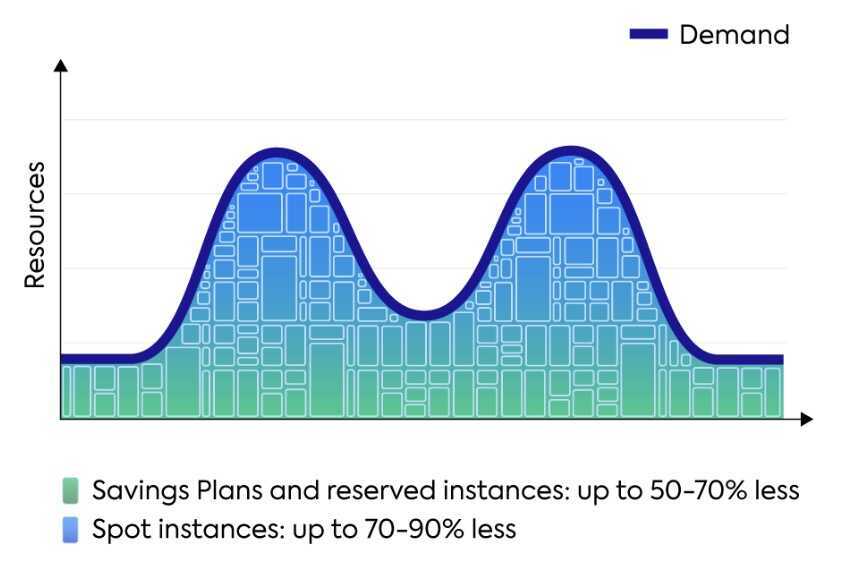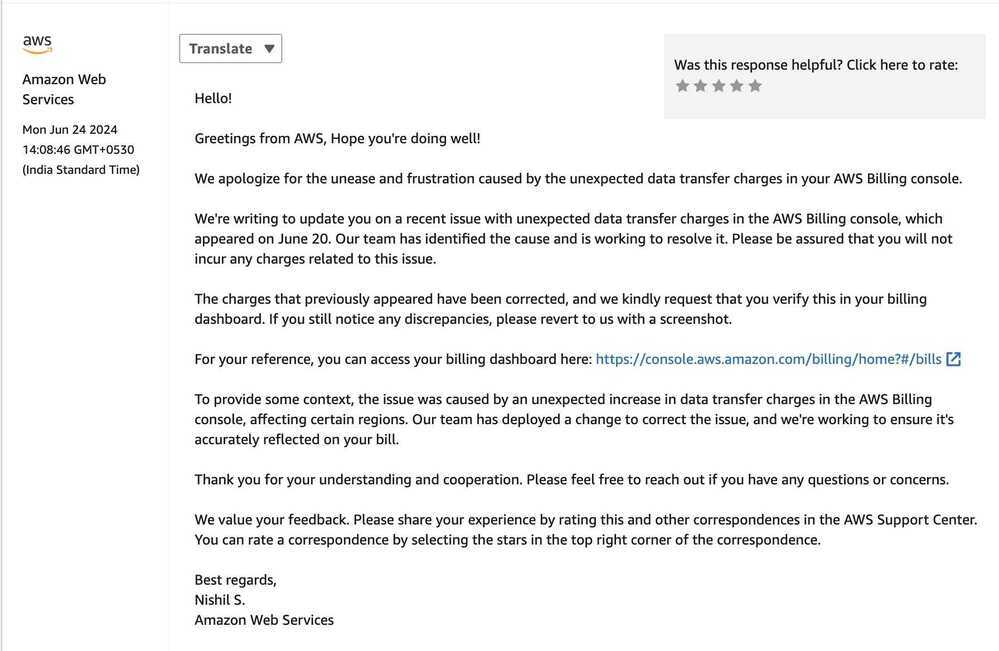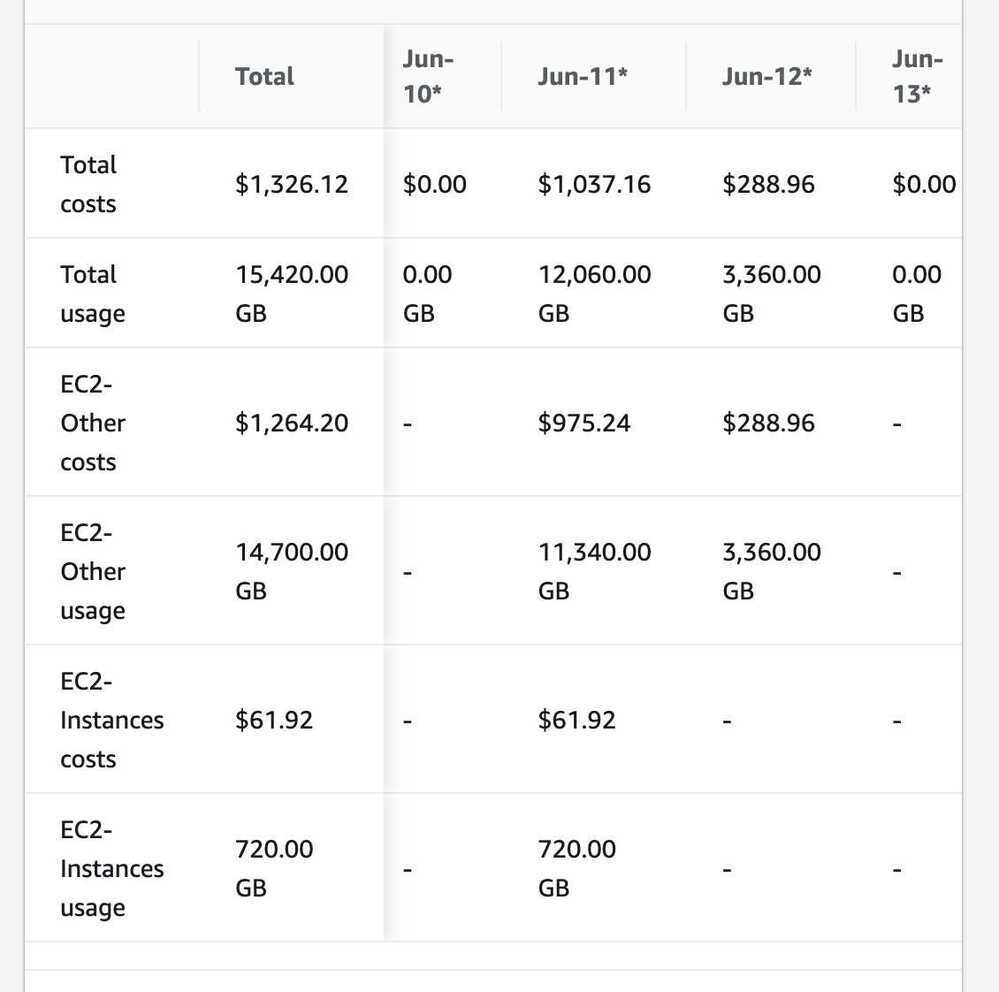Cost Optimization / Explorer / Billing
Cloud Financial Management with AWS
Billing access - How to allow an IAM user to access Billing Dashboard in AWS? | by Rohit Vyas | Medium
- On account settings page, scroll down and you will get “IAM User and Role Access to Billing Information” with “edit” link button.
- Mark this “Activate IAM Access” checkbox
Region Costs
- Oregon - 333.98
- N.Virginia - 333.98
- Singapore - 440.74
- Hyderabad - 433.53
AWS Cost Explorer
- APS3: Asia Pacific (Mumbai)
- APS5: Asia Pacific (Hyderabad)
- GDA - Glacier Deep Archive
- CUR - Cost and Usage Report - https://medium.com/@ayushsharma.in/taming-aws-costs-with-cost-and-usage-reports-aws-athena-d2536b35b234
Different Costs Type
Unblended costs
The vast majority of AWS customers use the unblended cost dataset to understand their usage. This is the cost dataset presented to you on the Bills page. It’s the default option for analyzing costs using AWS Cost Explorer or setting custom budgets using AWS Budgets.
Unblended costs represent your usage costs on the day they are charged to you. In finance terms, they represent your costs on a cash basis of accounting. For most of you, this is the only cost dataset that you will ever need.
Amortized costs
Viewing your amortized costs is useful in cases in which it doesn’t make sense to view your costs on the day that they were charged. Or, as many of finance owners say, it’s useful to view costs on an accrual basis rather than a cash basis. This cost dataset is especially useful for those of you who have purchased AWS Reservations such as Amazon EC2 Reserved Instances.
Savings Plans and Reservations often have upfront or recurring monthly fees associated with them. As you can see in the first chart, these recurring fees are charged on the first day of the month. That can lead to a spike on one day, if you are using unblended costs as your cost dataset. When you toggle over to amortized costs, these recurring costs (as well as any upfront costs) are distributed evenly across the month.
Blended costs
Blended costs were originally created to support customers who chose to consolidate their billing under a single paying account. Nowadays, these costs are not used frequently due to the way that they are calculated.
Blended costs are calculated by multiplying each account’s service usage against something called a blended rate. A blended rate is the average rate of on-demand usage, as well as Savings Plans- and reservation-related usage, that is consumed by member accounts in an organization for a particular service.
Understanding your AWS Cost Datasets: A Cheat Sheet | AWS Cloud Financial Management
AWS Cost Explorer now supports Hourly and Resource Level Granularity
Resource-level data at daily granularity - AWS Cost Management
- In Cost Explorer, you can enable resource-level data for your chosen AWS services at daily granularity for the past 14 days.
- We will disable resource-level data at daily granularity for your organization if no one in the organization accesses it in three consecutive months. However, if you need the data, you can re-enable it in Cost Management preferences.
Cost Anomaly Detection
AWS Cost Optimization Hub
Consolidate and Prioritize Cost Optimization Opportunities
Cost Optimization Hub allows you to easily identify, filter, and consolidate over 15 types of AWS cost optimization recommendations, such as EC2 instance rightsizing recommendations, Graviton migration recommendations, idle resource detection, and Savings Plans recommendations across your AWS accounts and AWS Regions within your organization through a single dashboard, so that you can get the most out of your AWS spend. Cost Optimization Hub helps you quantify and aggregate estimated savings of these recommendations, taking your specific discount with AWS, such as Reserved Instances and Savings Plans, into consideration, so you can easily compare and prioritize recommendations. With Cost Optimization Hub, you can get answers to your cost optimization questions within minutes, such as "How much can I save by implementing rightsizing recommendations?" "Which AWS accounts have the most cost optimization opportunities?" and "What are the top 3 actions I can take to save costs?" and drive cost optimization initiatives through a single pane of glass.
Introducing Cost Optimization Hub
Rightsizing Recommendations
Optimizing your cost with Rightsizing Recommendations - AWS Cost Management
AWS Compute Optimizer
NOTE:
- We can use this AWS service for Databases running on EC2 for rightsizing recommendation
- It did not provide recommendations specifically for Amazon RDS
Supported resources and requirements
Compute Optimizer generates recommendations for the following resources:
- Amazon Elastic Compute Cloud (Amazon EC2) instances
- Amazon EC2 Auto Scaling groups
- Amazon Elastic Block Store (Amazon EBS) volumes
- AWS Lambda functions
- Amazon Elastic Container Service (Amazon ECS) services on AWS Fargate
- Commercial software licenses
AWS Trusted Advisor
- We can use AWS Trusted Advisor service that provides best practice recommendations across various categories, including cost optimization.
- While it may not directly recommend RDS resizing, it offers insights into cost-effective resource utilization and can highlight opportunities for optimization.
- AWS Trusted Advisor is a service that analyzes your AWS environment and provides real-time, actionable recommendations to help you optimize your cloud infrastructure by improving cost savings, performance, security, operational excellence, and service limits. It scans your infrastructure to ensure it adheres to AWS best practices, offering suggestions to resolve issues and improve your overall cloud posture. Trusted Advisor Priority is an advanced version available to AWS Enterprise Support customers, offering context-driven, prioritized recommendations from their AWS account team.
- Recommendations
- Cost Optimization
- Performance
- Security
- Fault Tolerant
- Service Limits
Organizational view for AWS Trusted Advisor - AWS Support
CUDOS Dashboard / CID (Cloud Intelligence Dashboard)
- Workshop Studio
- Workshop Studio
- d1s0yx3p3y3rah.cloudfront.net/anonymous-embed?dashboard=cudos
- Using CUDOS Dashboard visualizations for AWS Marketplace spend visibility and optimization | AWS Marketplace
- Visualize and gain insights into your AWS cost and usage with Cloud Intelligence Dashboards and CUDOS using Amazon QuickSight | AWS Cloud Operations & Migrations Blog
- FOCUS Dashboard - YouTube
Savings Plan
- Savings plan is not application for spot instances
- Commit to a minimum amount of spending per hour for one or three years to receive a discount on On-Demand Instances. Savings Plans can offer up to 72% off the regular price. However, they can't be canceled during the term and can waste money if not fully utilized.
Spot Instances
Provide access to leftover capacity at a discount of up to 90% off the On-Demand price. However, they aren't guaranteed to be available and are not ideal for mission-critical workloads because AWS can reclaim them with just two minutes notice.

EC2 Spot Instances vs. AWS Savings Plans: What are the Potential Savings?
Spot vs. Savings Plans: How to Get Discounts Across All Of Your AWS Spend | nOps
Effective utilization of AWS Savings Plans and EC2 spot instances | Spot.io
Spot Instances - Amazon Elastic Compute Cloud
Best practices for EC2 Spot - Amazon Elastic Compute Cloud
Spot don't use savings plan
Spot instances do not use AWS Savings Plans
- Price: Spot instances are already up to 90% discounted, so other discounts like Savings Plans won't apply.
- Commitment: Savings Plans require a commitment and can't be canceled during the term.
- Usage: Savings Plans don't apply to spot usage or usage covered by Reserved Instances (RIs).
Spot instances can be a good option for applications that are fault-tolerant, stateless, or flexible, such as web servers, big data, and containerized workloads. However, because AWS can reclaim Spot instances with just a two minute warning, they might not be ideal for mission-critical or production workloads.
Spot Requests
A Spot Instance request is either one-time or persistent. If the spot request is persistent, the request is opened again after your Spot Instance is interrupted. If the request is persistent and you stop your Spot Instance, the request only opens after you start your Spot Instance.
If your Spot Instance request is active and has an associated running Spot Instance, or your Spot Instance request is disabled and has an associated stopped Spot Instance, canceling the request does not terminate the instance; you must terminate the running Spot Instance manually. Moreover, to cancel a persistent Spot request and terminate its Spot Instances, you must cancel the Spot request first and then terminate the Spot Instances.
Spot Fleet
A Spot Fleet is a set of Spot Instances and optionally On-Demand Instances that is launched based on criteria that you specify. The Spot Fleet selects the Spot capacity pools that meet your needs and launches Spot Instances to meet the target capacity for the fleet. By default, Spot Fleets are set to maintain target capacity by launching replacement instances after Spot Instances in the fleet are terminated. You can submit a Spot Fleet as a one-time request, which does not persist after the instances have been terminated. You can include On-Demand Instance requests in a Spot Fleet request.
Savings plan Utilization Report and Coverage Report
Utilization Report: Measures the amount of the savings plan you are using. If it's less than 100% it means that you reserved more than you need.
Coverage Report: Measures the percentage of your costs covered by the savings plan. If it's less than 100%, you can increase your savings plan to optimize costs.
Ideally, both should be 100%, but I would say that it's more important to keep the utilization report at 100% because it's already a fixed cost that you already acquired. The coverage report indicates further improvement opportunities to reduce costs.
- amazon web services - Difference Between AWS SAVING PLAN Coverage Report vs Utilization Report - Stack Overflow
- Using the utilization report - Savings Plans
- Using your coverage report - Savings Plans
- Compute Savings Plans – Amazon Web Services
Reserved Instances
With Aurora MySQL they have size flexibility -- so they can purchase a T3.Large, and run 4 T3.Smalls to get the discount (or whatever the size factor is). However, they must commit to the T3 family. They will not be able to get the discount by running a T2 RDS instance. That T2 will be billed on-demand rates.
Also RDS RI purchased in one account can be used in another account if RI sharing is enabled (consolidated billing).
If running a instance for less than 12-15 hours then on-demand can be cheaper than RI, since RI's cost is 24 hours, and doesn't depend on if the instance is used or not.
- Reserved Instances for RDS Aurora | AWS re:Post
- Reserved Instances and Savings Plans discount sharing - AWS Billing
- Billing examples for specific services - AWS Billing
- Does RI sharing in orgs apply to RDS RIs too? | AWS re:Post
Reservations Utilization Report and Coverage Report
Other Tools
Tools for checking costs
- GitHub - concurrencylabs/aws-cost-analysis: Tools that make it easier to analyze AWS Cost and Usage reports. Initial version provides support for Athena and QuickSight.
- GitHub - hystax/optscale: FinOps and cloud cost optimization tool. Supports AWS, Azure, GCP, Alibaba Cloud and Kubernetes.
- Economize Cloud – Cloud Cost Optimization Software
Alerting
- Email delta cost usage report in a multi-account organization using AWS Lambda | AWS Architecture Blog
- Generate AWS cost reports automatically using the Cost-Explorer API | by TechStoryLines | Medium
Wrong Costs


AWS Support
AWS Support Plans - AWS Support
- Basic - free and included for all AWS customers
- Developer
- Business
- Enterprise On-Ramp
- Enterprise
Links
- Aurora - configurations-optimizations-best-practices
- Understanding your AWS billing and usage reports for Amazon S3 - Amazon Simple Storage Service
- AWS tools to optimize your Amazon RDS costs | AWS Database Blog
- AWS Cost Anomaly Detection - Automated cost anomaly detection and root cause analysis
- Cost optimization - AWS Support
- Understanding Consolidated Bills - AWS Billing
- Best Practices for AWS Organizations
- Amazon Q for Cost Analysis | The Keys to AWS Optimization | S10 E10 - YouTube